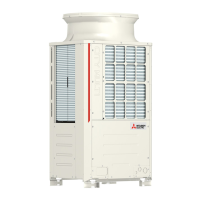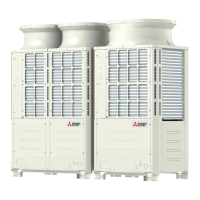
Do you have a question about the Mitsubishi Electric PUHY-P550 and is the answer not in the manual?
| Power Source | 3-phase |
|---|---|
| Power Supply | 380-415V, 50Hz |
| Refrigerant | R410A |
| Series | CITY MULTI |
| Type | Outdoor Unit |
Covers warning and caution symbols, general warnings like not touching fins, and ventilation after refrigerant leaks.
Covers installation, electrical safety, unit handling, modifications, and location precautions.
Specific precautions for R410A, including piping, tools, charging, and storage.
Guidelines on selecting installation locations and environments, avoiding gas leaks and unusual conditions.
Essential checks before test run, including unit power-on time, wet hands, pipe handling, and air filters.
Lists required tools and materials for installation and servicing, specifying R410A compatibility.
Details piping materials, processing techniques, and brazing procedures to prevent contamination.
Covers air tightness testing, vacuum drying, refrigerant charging, and leak remedies.
Compares refrigerant characteristics and provides notes on refrigerating machine oil for HFC systems.
Summarizes compatible indoor units for outdoor units and standard/high COP combinations.
Details cable types, lengths, wiring methods, switch settings, and M-NET address configurations.
Covers power supply connectors, centralized control switches, temperature detection, and start-stop controls.
Explains demand control for cooling/heating operation and step control settings.
Provides sample connection diagrams for systems with MA, ME, LOSSNAY, and system controllers.
Details allowable pipe lengths for end branching and specific pipe sizes for refrigerant lines.
Illustrates outdoor unit components and provides refrigerant circuit diagrams for various models.
Details the control box layout and the outdoor unit circuit board with all connectors and switches.
Provides diagrams for M-NET board, INV board, Fan board, and Noise Filter components.
Compares MA and ME remote controllers' functions, specifications, and selection criteria.
Explains group settings, interlock settings with LOSSNAY, and function selection for ME controllers.
Details how to set up LOSSNAY interlocks with indoor units using the MA remote controller.
Provides detailed electrical wiring diagrams for outdoor units, showing component connections.
Illustrates the electrical wiring connections for the transmission booster.
Illustrates refrigerant circuits for various outdoor unit models.
Details key components within the refrigerant circuit, their symbols, usage, and specifications.
Details functions and factory settings of DIP switches on outdoor unit control boards.
Explains DIP switch functions for indoor units, including temperature detection and fan speed settings.
Covers remote controller switch functions, address settings, and operation modes.
Explains control methods, startup sequences, initial control, and start-up behavior of outdoor units.
Details bypass control, refrigerant recovery, compressor frequency, defrost, LEV, and demand control.
Lists items to check before a test run and outlines the test run procedure.
Provides operating characteristics, refrigerant amounts, adjustment modes, and standard data.
Presents operating data for High-COP models during cooling and heating operations.
Lists error codes, their definitions, and how to respond to errors displayed on the remote controller.
Troubleshooting guides for specific error codes related to temperature, pressure, drain, phase, and fan issues.
Addresses inverter errors, bus voltage issues, communication errors, and system configuration faults.
Covers troubleshooting for MA and ME remote controller malfunctions, including power and wiring issues.
Guides for troubleshooting specific components like sensors, valves, fans, and LEV.
Explains how to read LED displays and information shown during initial unit setup.
Table mapping SW1 settings to various current data items displayed on the LED monitor.
Table mapping SW1 settings to various configuration data items displayed on the LED monitor.
Table mapping SW1 settings to display indoor unit system data, including temperatures and modes.
Table mapping SW1 settings to display other system data like reset counters and filter status.












